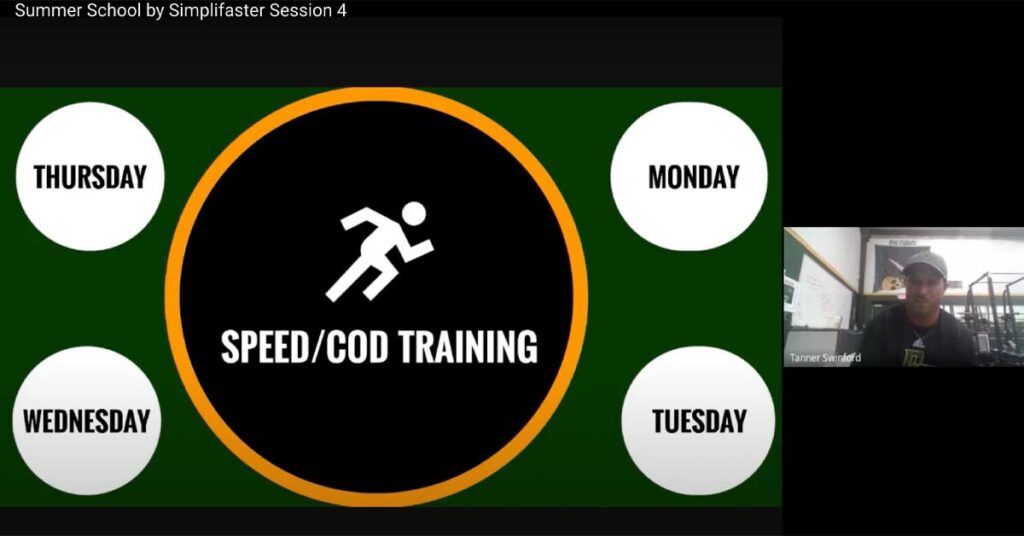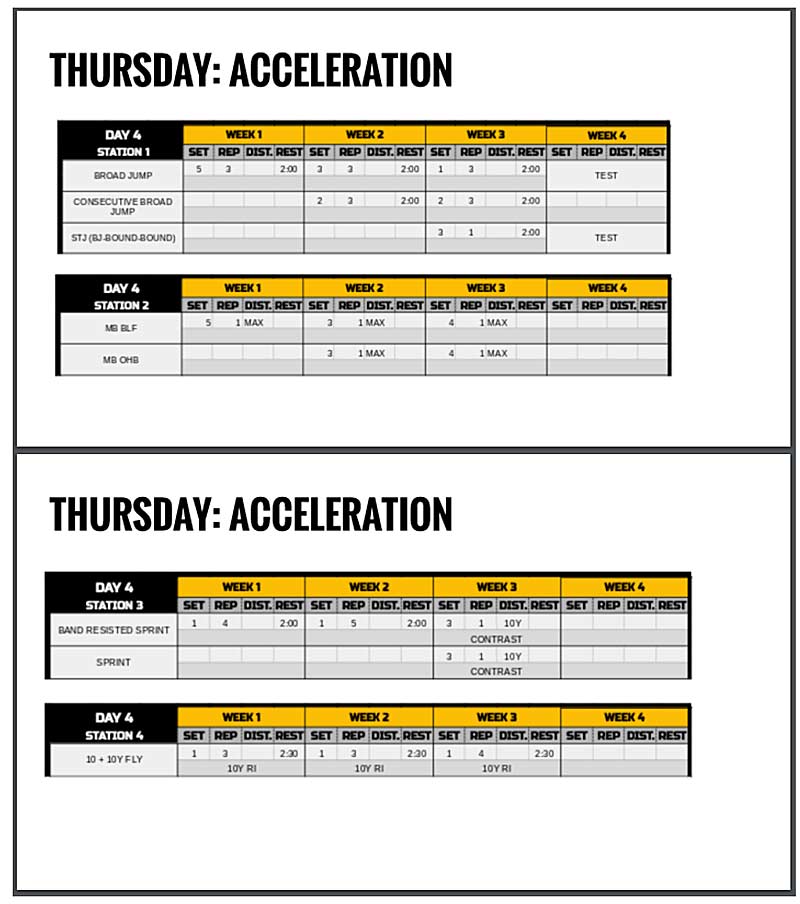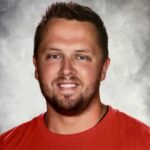
Week Four of Summer School featured another coach with an excellent vision for their program—Coach Tanner Swinford, the Strength & Conditioning coach from Rockport-Fulton High School. Coach Swinford joined us to discuss the opening month of his first program in the high school setting and eloquently communicated his vision for training field and court athletes as a complementary approach. He detailed his own experience as an athlete: riddled with injury and dealing with a separation of skill transfer between the weight room and the field, which ultimately produced a powerful athlete who couldn’t do as much as he potentially could have if the gap between the two were bridged.
Coach Swinford’s complimentary approach prioritizes efficient movement on the field, evident by his detailed approach to speed programming. He bridges the gap by implementing COD teaching using the grid system and a competition-based approach to break up the potential monotony of training. This competition-style approach is built over the course of a block in order to ensure all pieces of the needed skills in that match-up are taught and repped prior to the competition.

Programming with Small-Sided Games
This episode provided excellent insight into the field-based progressions that Coach Swinford is using in order to build his program. Taking inspiration from Dan Pfaff, Charlie Francis, Les Spellman, and Boo Schexnayder, the fundamental tenets of speed are each met in Coach Swinford’s comprehensive program. A highlight of this session is how Coach Swinford mixes up his agility work with innovative, small-sided games to allow for competition while still achieving the stimulus he desires.
“The kids really like this,” Swinford said of their partner-based chase and shadow games. “For me this is just a substitute for traditional tempo, but the kids stay more engaged in it and they really enjoy doing it.”
Coach details multiple weeks of these options in the discussion of his program—listeners can fill several pages of notes on the speed section of this episode alone.
Video 1. This week’s full session with Coach Tanner Swinford.
Panel Q&A
This week’s panel included Coach Aja Campbell, Director of S&C at The Mary Louis Academy and owner of ATTAGIRL; SimpliFaster’s own Mark Hoover; and Joe Stokowski from Grayson HS in Loganville, Georgia.
Coach Aja Campbell asked: “At this time of the year, with the number of athletes and the diversity of age and sport that you coach, how do you manage coaching recovery and nutrition?”
Coach Swinford: “Before each session, I try to explain to my athletes that while our time together is limited, and we will train hard and push for adaptation, you must take care of your body the other 22 hours each day. I use the analogy of the bank—if you’re not going to the bank (proper nutrition) to make the deposit, you won’t be able to withdraw later (performance). We use SportsU for communication, and I try to post content there for our athletes and parents to get good information on recovery and nutrition to save time and increase the chances of information sticking.”
I use the analogy of the bank—if you’re not going to the bank (proper nutrition) to make the deposit, you won’t be able to withdraw later (performance), says @TannerSwinford. Share on XCoach Joe Stokowski: “How are you differentiating multiple sports with the number of athletes and the time that you have them?”
Coach Swinford: “So far this off-season, because I just took over for this program, the first four weeks have been general athletic training without much differentiation. The reason for this is that I want to see how our kids move, what general competencies they execute well, and what general work we need. For instance, we aren’t good hingers right now, so I am making note of that so we can teach and regress when needed. When we get to school, it will be easier because I will have smaller groups—but right now, with groups of over 100 athletes at a time with minimal help from other coaches, my goals are general and to assess what we can and cannot do.
Coach Mark Hoover: “Do you get much resistance when you try to implement a regression from, for instance, a back squat?”
Coach Swinford: “It has been tough in that regard, because for so long here, it’s been about load it up and then we would complete whatever our workout was…and then kids would go max out their deadlift after school! What has really helped has been gaining buy-in from our ‘best’ players and those in the weight room. Other athletes seeing our top performers excel and benefit from our programming is certainly helping gain buy-in from other athletes who have been relatively resistant.”
What has really helped has been gaining buy-in from our ‘best’ players…other athletes seeing our top performers excel and benefit from our programming is certainly helping gain buy-in, says @TannerSwinford. Share on XNext Week
On Tuesday, July 11, we will hear from Muhammad Abdellatif, the Strength and Conditioning Coach at Rome High School in Rome, Georgia. Coach A will be talking about his transition to a football powerhouse in Rome and how he’s earned buy-in from a legendary coach and some big-time players in a short amount of time. See you Tuesday at 8:00p.m. EST, click this link to join!
Since you’re here…
…we have a small favor to ask. More people are reading SimpliFaster than ever, and each week we bring you compelling content from coaches, sport scientists, and physiotherapists who are devoted to building better athletes. Please take a moment to share the articles on social media, engage the authors with questions and comments below, and link to articles when appropriate if you have a blog or participate on forums of related topics. — SF

